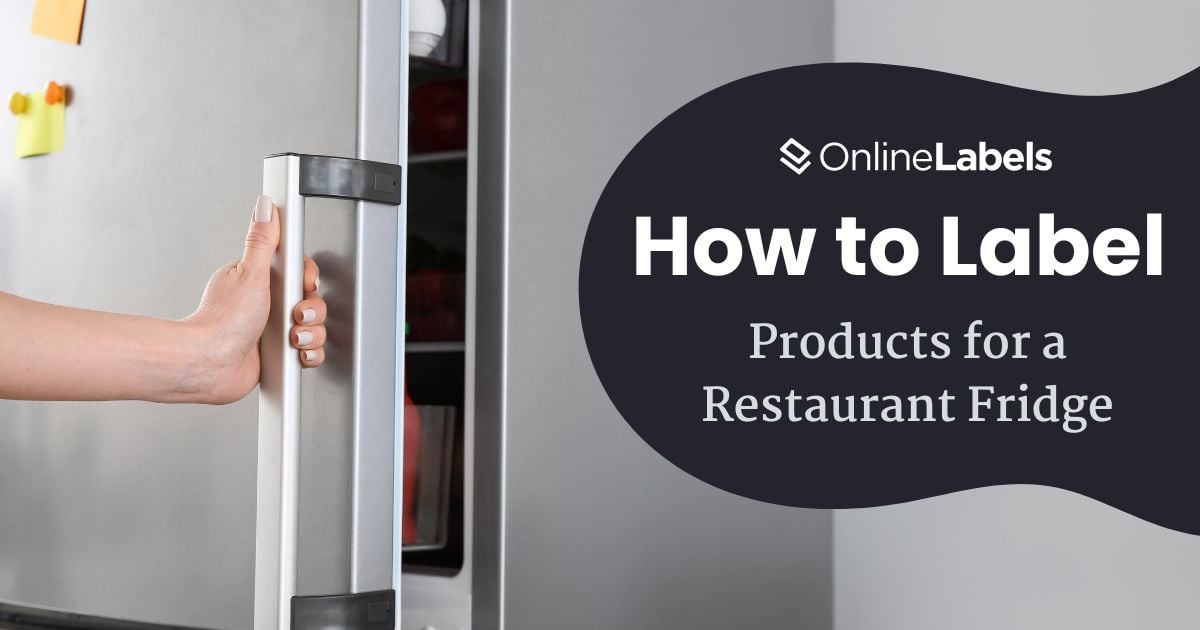How to Label Products for a Restaurant Fridge

What if a simple labeling system could transform your kitchen operations?
Organizing a fridge or freezer with labels can be a game-changer for any restaurant. It speeds up operations, helps keep food quality high, and aids your staff in quickly finding the necessary ingredients.
Importance of Properly Labeling the Products in a Fridge or Freezer
An organized fridge can make or break your business.
A refrigerator serves as the central hub in a kitchen's operations. It helps slow bacterial growth and ensures that perishable items remain safe from spoilage. A good understanding of how the different parts of a fridge work can help ensure that every section is used effectively and keep ingredients fresh and ready to use.
Proper organization of the products in a restaurant can help boost several aspects of a kitchen, including:
How to Properly Organize a Commercial Fridge
Before organizing your fridge with labels, you must understand the different compartments and consider each section's various climate conditions. A commercial fridge is usually divided into five parts: the crisper drawers, the lower shelf, the upper shelf, the meat/deli shelf, and, in some cases, the refrigerator wall.

- Meat/deli shelf: this shelf is perfect for products that need cooler temperatures. It keeps products such as meat, cheeses, and fish at a recommended low temperature of 32 degrees Fahrenheit. Labels can survive in this temperature as long as they are weatherproof.
- Crisper drawers: this side of the fridge is designed for freshness. This is ideal for vegetables or fruit products since its low temperature can help maintain their humidity.
- Lower shelf: this is typically the coldest part of the fridge! Place products that have a greater tendency to rot or develop bacteria here, such as milk or eggs.
- Upper shelf: this side of the fridge is the warmest, contrasting with the lower shelf. Place items that don't spoil quickly, like peanut butter and jelly, on this shelf.
- Fridge door: some fridges include a door compartment with a higher temperature than the other compartments. This door is mainly used for items stored at temperatures up to 110 degrees Fahrenheit, such as juice, condiments, soda, etc.
- If your commercial fridge doesn't include door compartments, include these food items on the upper shelf.
Establish Zones for Each Item
Establishing zones for each item in a restaurant fridge is crucial for maintaining food safety, ensuring efficiency, and preventing cross-contamination. Here’s a step-by-step guide to help you set up these zones effectively:
Categorize Food Items
Start by analyzing your business's different types of items. This will vary depending on the type of business; however, it is important to label each food item and place them in categories.
Labeling the products is essential to communicate information to kitchen staff. Categorize each element depending on the type of product. Our Diet and allergy label selection can help communicate food properties that may be harmful if they are mixed up.
Create a Fridge Map
Draw a map of the fridge layout and designate specific areas for each category. Use weatherproof labels to ensure each category is visible, and divide the fridge according to categories. If the products contain gluten-free or dairy-free elements, create a category in the refrigerator where they can be placed to prevent cross-contamination.
A suggestion for organizing your fridge can be dividing categories as follows:
- Raw meat, poultry, and seafood: these items must be stored on the lowest shelves to prevent juices from dripping onto other foods and can be placed in the meat/deli compartment.
- Ready-to-eat foods: store these on the top shelves. This includes cooked meats, dairy products, and prepared salads.
- Fruits and vegetables: typically can be stored in the crisper drawers to maintain freshness and prevent ethylene gas from spoiling other produce.
- Dairy products: milk, cheese and other dairy items can be placed on middle shelves.
- Food and dietary products: products created exclusively for allergies, such as gluten and dairy, can be placed on the lower shelf to prevent cross-contamination with the crisper drawers.
Label Methods for Organizing a Fridge Efficiently
Besides labeling food items by name and category, other methods can help us better understand the fridge's contents. A few label methods can help improve food safety and organization during cooking.
Implementing Color Coded Labels
Visual cues can be used as additional components following written instructions, especially in a busy kitchen where quick decision-making is essential. Color coding, as a part of visual management, can significantly enhance operational efficiency. New and existing staff can quickly learn and remember the significance of different colors, simplifying training and ensuring everyone follows the same protocols. Our food delivery labels have recognizable colors that help differentiate the products.
Rotation System to Prevent Rotting
To prevent the rotting of older products, labels can help categorize new products from old ones so that all products are used to their full potential. This can help the kitchen staff better understand the inventory and prevent food waste. This is especially important for products with a short shelf life, such as milk, cream, and fruit.
- Implement FIFO (First in, First Out): the FIFO strategy uses old products before newer ones. This system is essential in preventing items from sitting unused until they spoil, thereby reducing the risk of rotting food in storage.
Maximize Kitchen Efficiency with Fridge Organization
Implementing a comprehensive labeling system in your restaurant's fridges and freezers is not just a matter of organization—it's a vital component of maintaining food safety, operational efficiency, and regulatory compliance. By clearly identifying each product and assigning it to the appropriate zone within your fridge, you ensure that your staff can quickly find ingredients, reduce the risk of cross-contamination, and extend the shelf life of perishable items. Embrace these practices to streamline operations and uphold the highest food quality and safety standards.
Get organized in your kitchen today by shopping our selection of restaurant labels.



